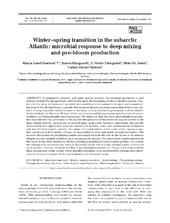| dc.contributor.author | Paulsen, Maria Lund | |
| dc.contributor.author | Riisgaard, Karen | |
| dc.contributor.author | Frede, Thingstad | |
| dc.contributor.author | St. John, Mike | |
| dc.contributor.author | Nielsen, Torkel Gissel | |
| dc.date.accessioned | 2016-01-15T13:41:53Z | |
| dc.date.available | 2016-01-15T13:41:53Z | |
| dc.date.issued | 2015-09-23 | |
| dc.Published | Aquatic Microbial Ecology 2015, 76:49-69 | eng |
| dc.identifier.issn | 1616-1564 | en_US |
| dc.identifier.uri | https://hdl.handle.net/1956/10971 | |
| dc.description.abstract | In temperate, subpolar and polar marine systems, the classical perception is that diatoms initiate the spring bloom and thereby mark the beginning of the productive season. Contrary to this view, we document an active microbial food web dominated by pico- and nanoplankton prior to the diatom bloom, a period with excess nutrients and deep convection of the water column. During repeated visits to stations in the deep Iceland and Norwegian basins and the shallow Shetland Shelf (26 March to 29 April 2012), we investigated the succession and dynamics of photosynthetic and heterotrophic microorganisms. We observed that the early phytoplankton production was followed by a decrease in the carbon:nitrogen ratio of the dissolved organic matter in the deep mixed stations, an increase in heterotrophic prokaryote (bacteria) abundance and activity (indicated by the high nucleic acid:low nucleic acid bacteria ratio), and an increase in abundance and size of heterotrophic protists. The major chl a contribution in the early winter-spring transition was found in the fraction <10 µm, i.e. dominated by pico- and small nanophytoplankton. The relative abundance of picophytoplankton decreased towards the end of the cruise at all stations despite nutrient-replete conditions and increasing day length. This decrease is hypothesised to be the result of top-down control by the fast-growing population of heterotrophic protists. As a result, the subsequent succession and nutrient depletion can be left to larger phytoplankton resistant to small grazers. Further, we observed that large phytoplankton (chl a > 50 µm) were stimulated by deep mixing later in the period, while picophytoplankton were unaffected by mixing; both physical and biological reasons for this development are discussed herein. | en_US |
| dc.language.iso | eng | eng |
| dc.publisher | Inter-Research Science Center (IR) | en_US |
| dc.relation.ispartof | <a href="http://hdl.handle.net/1956/17362" target="blank">Microbial dynamics in high latitude ecosystems. Responses to mixing, runoff and seasonal variation a rapidly changing environment</a> | en_US |
| dc.rights | Attribution CC BY 3.0 | eng |
| dc.rights.uri | http://creativecommons.org/licenses/by/3.0 | eng |
| dc.subject | Microbial food web | eng |
| dc.subject | Winter−spring transition | eng |
| dc.subject | Deep mixing | eng |
| dc.subject | Picophytoplankton | eng |
| dc.subject | Nanophytoplankton | eng |
| dc.subject | Bacteria | eng |
| dc.subject | Heterotrophic nanoflagellates | eng |
| dc.subject | Microzooplankton | eng |
| dc.subject | Subarctic Atlantic | eng |
| dc.title | Winter−spring transition in the subarcticAtlantic: microbial response to deep mixingand pre-bloom production | en_US |
| dc.type | Peer reviewed | |
| dc.type | Journal article | |
| dc.date.updated | 2015-09-25T14:13:17Z | |
| dc.description.version | publishedVersion | en_US |
| dc.rights.holder | Copyright 2015 The Authors | en_US |
| dc.identifier.doi | https://doi.org/10.3354/ame01767 | |
| dc.identifier.cristin | 1275443 | |
| dc.subject.nsi | VDP::Matematikk og Naturvitenskap: 400 | en_US |

